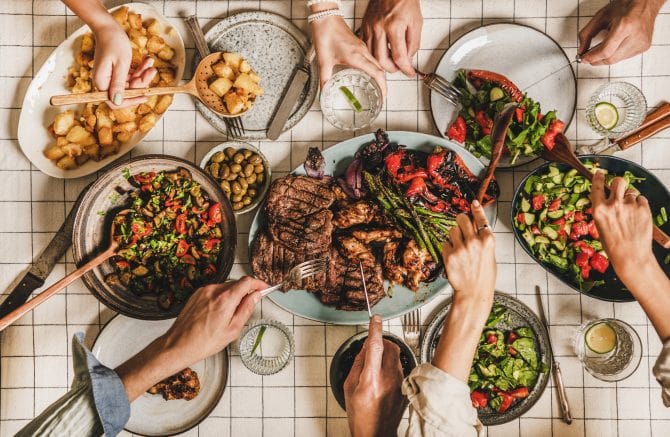 As summer finds us spending more time outdoors, relaxing evenings seem to be the perfect time for cooking a succulent dinner on the grill. But do you want to stick with the usual stand-by of burgers and hot dogs, or would you like to try something more complex?
As summer finds us spending more time outdoors, relaxing evenings seem to be the perfect time for cooking a succulent dinner on the grill. But do you want to stick with the usual stand-by of burgers and hot dogs, or would you like to try something more complex?
From lamb to salmon to various kinds of vegetables, there are many things that can be cooked over a hot grill—and lots of unique sauces and spices to give them extra flavor. CRRL’s collection can help you find techniques and recipes for grilling all kinds of food, while this post explains the differences between kinds of grills, as well as well as some spices you may not be familiar with.
First, Find the Right Grill
There are several different types of grills that you can use. I use a charcoal grill, which is the oldest style of backyard barbeque. The typical charcoal grill is kettle-shaped and uses lighted charcoal briquettes to cook the food; it is possible to put the lid down on the grill while cooking to give a smokier taste. A major advantage of the charcoal grill is that it can be used to prepare food with little specialized equipment other than some wood and the briquettes themselves. A disadvantage is that it is very difficult to control the temperature of the grill.
Gas grills typically come on a cart and require a propane tank and sparker to start, although some of them run off natural gas (the type used to heat homes) instead. They allow users to more easily control the temperature of parts of the grill through dials or knobs and provide a quicker start to the fire, but are more expensive to buy, and it can be difficult to get a “well-smoked” taste on some foods via a gas grill.
Electric grills are also frequently used, although the most popular of these are portable indoor grills that use a clamshell design to heat the meat, such as the George Foreman grill. Larger outdoor electric grills are also available, but these must be plugged into an electrical outlet nearby. Large electric grills are typically less popular than equivalent gas grills because they are more expensive and are considered to offer the “least authentic” grilled taste.
There are a couple more types of grill that are less common in the United States. A hibachi grill is a small, charcoal-fired grill typically made from cast iron. The name “hibachi” is a bit of a misnomer; this style of grill is called “shichirin” in its native Japan. Hibachis are typically small, portable, and box-shaped, but the techniques required to grill on such a small surface are often unfamiliar to Americans. Pellet grills,, opens a new window a kind of grill that uses wood pellets rather than charcoal for heat, are the newest type of grill, having only been developed from pellet stoves in the 1980s. Pellet grills use a variety of wood pellets—such as mesquite, hickory, and oak to give the grilled food a distinct taste. Unlike charcoal grills, pellet grills can maintain a steady temperature via the electronic controls of an internal fan. Pellet grills require electricity to work, which can make them less convenient than charcoal or gas grills in some circumstances.
Beyond Burgers and Hot Dogs
It’s always fun to grill burgers and hot dogs on a hot summer afternoon, but why not try something more adventurous for a change? It’s possible to prepare fish on an outdoor grill. For salmon, you’ll need either foil or a tray, and oil or marinade to provide moisture for the fish. Tuna can simply be cooked on the grill itself because the flesh is oily enough to grill well. Try cooking lamb on the grill as well. Lamb can be grilled in the form of patties or steaks, and preparation and heating is similar to beef. Instead of hot dogs, you can try grilling other kinds of sausage like chorizo or Italian sausage. There are many options to choose from for grilling meat!
Some vegetables can be prepared on an outdoor grill as well. Corn is the easiest to prepare, as it requires no special tray or pan. Corn should be soaked in water before being put on the grill so that it does not become overly burnt or dry, though. Other types of vegetables require a tray or pan to be grilled, including zucchini, peppers, and onions. Grilling vegetables can provide a unique taste different than that of boiling or sauteing. Grilling vegetables is also a great way to make use of the heated grill once you’ve prepared the meat.
A Splash of Flavor: Sauces and Spices
Many types of food benefit from distinctive spices. Lamb, in particular is good with Middle Eastern flavors, such as shawarma spices or ras el hanout. Pork can benefit from a wide variety of marinades, rubs, and barbeque sauces to soften and flavor the meat before grilling. Steak can benefit from things as simple as ground pepper to shawarma blends and even wine-based marinades. The right sauce, spice, or marinade will help you make the results of your grilling session a meal to remember.
CRRL’s collection is your next step in learning how to become a great griller. We’ve created a book list to help you learn all about many grilling techniques and savories that you can prepare in the open air or in the comfort of your kitchen as you discover Middle Eastern- and Japanese-style grilling, how to grill fish, vegetables, and more.


